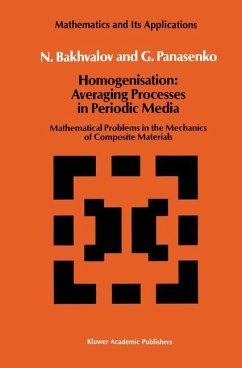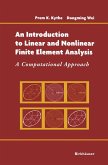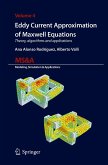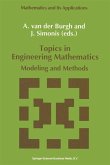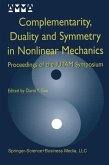N. S. Bakhvalov, G. Panasenko
Homogenisation: Averaging Processes in Periodic Media
Mathematical Problems in the Mechanics of Composite Materials
N. S. Bakhvalov, G. Panasenko
Homogenisation: Averaging Processes in Periodic Media
Mathematical Problems in the Mechanics of Composite Materials
- Broschiertes Buch
- Merkliste
- Auf die Merkliste
- Bewerten Bewerten
- Teilen
- Produkt teilen
- Produkterinnerung
- Produkterinnerung
'Et moi, .... si j'avait su comment en revenir, One service mathematics has rendered the je n'y semis point all,,: human race. It has put common sense back Jules Verne where it belongs, on the topmost shelf next to the dusty canister labelled 'discarded non The series is divergent: therefore we may be sense'. able to do something with it. Eric T. Bell O. Heaviside Mathematics is a tool for thought. A highly necessary tool in a world where both feedback and non !inearities abound. Similarly, all kinds of parts of mathematics serve as tools for other parts and for other sciences. Applying a…mehr
Andere Kunden interessierten sich auch für
![Partially Integrable Evolution Equations in Physics Partially Integrable Evolution Equations in Physics]() Partially Integrable Evolution Equations in Physics39,99 €
Partially Integrable Evolution Equations in Physics39,99 €![An Introduction to Linear and Nonlinear Finite Element Analysis An Introduction to Linear and Nonlinear Finite Element Analysis]() Prem KytheAn Introduction to Linear and Nonlinear Finite Element Analysis38,99 €
Prem KytheAn Introduction to Linear and Nonlinear Finite Element Analysis38,99 €![Eddy Current Approximation of Maxwell Equations Eddy Current Approximation of Maxwell Equations]() Ana Alonso RodriguezEddy Current Approximation of Maxwell Equations82,99 €
Ana Alonso RodriguezEddy Current Approximation of Maxwell Equations82,99 €![Systems of Evolution Equations with Periodic and Quasiperiodic Coefficients Systems of Evolution Equations with Periodic and Quasiperiodic Coefficients]() Yuri A. MitropolskySystems of Evolution Equations with Periodic and Quasiperiodic Coefficients39,99 €
Yuri A. MitropolskySystems of Evolution Equations with Periodic and Quasiperiodic Coefficients39,99 €![Symmetries of Maxwell's Equations Symmetries of Maxwell's Equations]() W. I. FushchichSymmetries of Maxwell's Equations100,99 €
W. I. FushchichSymmetries of Maxwell's Equations100,99 €![Topics in Engineering Mathematics Topics in Engineering Mathematics]() Topics in Engineering Mathematics39,99 €
Topics in Engineering Mathematics39,99 €![Complementarity, Duality and Symmetry in Nonlinear Mechanics Complementarity, Duality and Symmetry in Nonlinear Mechanics]() Complementarity, Duality and Symmetry in Nonlinear Mechanics153,99 €
Complementarity, Duality and Symmetry in Nonlinear Mechanics153,99 €-
-
-
'Et moi, .... si j'avait su comment en revenir, One service mathematics has rendered the je n'y semis point all,,: human race. It has put common sense back Jules Verne where it belongs, on the topmost shelf next to the dusty canister labelled 'discarded non The series is divergent: therefore we may be sense'. able to do something with it. Eric T. Bell O. Heaviside Mathematics is a tool for thought. A highly necessary tool in a world where both feedback and non !inearities abound. Similarly, all kinds of parts of mathematics serve as tools for other parts and for other sciences. Applying a simple rewriting rule to the quote on the right above one finds such statements as: 'One service topology has rendered mathematical physics .. .'; 'One service logic has rendered com puter science .. .'; 'One service category theory has rendered mathematics .. .'. All arguably true. And all statements obtainable this way form part of the raison d'etre of this series.
Produktdetails
- Produktdetails
- Mathematics and Its Applications 36
- Verlag: Springer / Springer Netherlands
- Artikelnr. des Verlages: 978-94-010-7506-0
- Softcover reprint of the original 1st ed. 1989
- Seitenzahl: 408
- Erscheinungstermin: 27. September 2011
- Englisch
- Abmessung: 235mm x 155mm x 23mm
- Gewicht: 616g
- ISBN-13: 9789401075060
- ISBN-10: 9401075069
- Artikelnr.: 39495550
- Herstellerkennzeichnung
- Springer-Verlag GmbH
- Tiergartenstr. 17
- 69121 Heidelberg
- ProductSafety@springernature.com
- Mathematics and Its Applications 36
- Verlag: Springer / Springer Netherlands
- Artikelnr. des Verlages: 978-94-010-7506-0
- Softcover reprint of the original 1st ed. 1989
- Seitenzahl: 408
- Erscheinungstermin: 27. September 2011
- Englisch
- Abmessung: 235mm x 155mm x 23mm
- Gewicht: 616g
- ISBN-13: 9789401075060
- ISBN-10: 9401075069
- Artikelnr.: 39495550
- Herstellerkennzeichnung
- Springer-Verlag GmbH
- Tiergartenstr. 17
- 69121 Heidelberg
- ProductSafety@springernature.com
1. Formulation of Elementary Boundary Value Problems.- 1. The Concept of the Classical Formulation of a Boundary Value Problem for Equations with Discontinuous Coefficients.- 2. The Concept of Generalized Solution.- 3. Generalized Formulations of Problems for the Basic Equations of Mathematical Physics.- 2. The Concept of Asymptotic Expansion. A Model Example to Illustrate the Averaging Method.- 1. Asymptotic expansion. A Formal Asymptotic Solution.- 2. Asymptotic Expansion of a Solution of the Equation u = 1 + ?u3.- 3. Asymptotic Expansion of a Solution of the Equation (K(x/?)u?)?= f(x) by the Averaging Method.- 4. Generalization of the Averaging Method in the Case of a Piecewise Smooth Coefficient.- 5. Averaging the System of Differential Equations.- 3. Averaging Processes in Layered Media.- 1. Problem of Small Longitudinal Vibrations of a Rod.- 2. Nonstationary Problem of Heat Conduction.- 3. Averaging Maxwell Equations.- 4. Averaging Equations of a Viscoelastic Medium.- 5. Media with Slowly Changing Geometric Characteristics.- 6. Heat Transfer Through a System of Screens.- 7. Averaging a Nonlinear Problem of the Elasticity Theory in an Inhomogeneous Rod.- 8. The System of Equations of Elasticity Theory in a Layered Medium.- 9. Considerations Permitting Reduction of Calculations in Constructing Averaged Equations.- 10. Nonstationary Nonlinear Problems.- 11. Averaging Equations with Rapidly Oscillating Nonperiodic Coefficients.- 12. Problems of Plasticity and Dynamics of Viscous Fluid as Described by Functions Depending on Fast Variables.- 4. Averaging Basic Equations of Mathematical Physics.- 1. Averaging Stationary Thermal Fields in a Composite.- 2. Asymptotic Expansion of Solution of the Stationary Heat ConductionProblem.- 3. Stationary Thermal Field in a Porous Medium.- 4. Averaging a Stationary System of Equations of Elasticity Theory in Composite and Porous Materials.- 5. Nonstationary Systems of Equations of Elasticity and Diffusion Theory.- 6. Averaging Nonstationary Nonlinear System of Equations of Elasticity Theory.- 7. Averaging Stokes and Navier-Stokes Equations. The Derivation of the Percolation Law for a Porous Medium (Darcy's Law).- 8. Averaging in case of Short-Wave Propagation.- 9. Averaging the Transition Equation for a Periodic Medium.- 10. Eigenvalue Problems.- 5. General Formal Averaging Procedure.- 1. Averaging Nonlinear Equations.- 2. Averaged Equations of Infinite Order for a Linear Periodic Medium and for the Equation of Moment Theory.- 3. A Method of Describing Multi-Dimensional Periodic Media that does not Involve Separating Fast and Slow Variables.- 6. Properties of Effective Coefficients. Relationship Among Local and Averaged Characteristics of a Solution.- 1. Maintaining the Properties of Convexity and Symmetry of the Minimized Functional in Averaging.- 2. On the Principle of Equivalent Homogeneity.- 3. The Symmetry Properties of Effective Coefficients and Reduction of Periodic Problems to Boundary Value Problems.- 4. Agreement Between Theoretically Predicted Values of Effective Coefficients and Those Determined by an Ideal Experiment.- 7. Composite Materials Containing High-Modulus Reinforcement.- 1. The Stationary Field in a Layered Material.- 2. Composite Materials with Grains for Reinforcement.- 3. Dissipation of Waves in Layered Media.- 4. High-Modulus 3D Composite Materials.- 5. The Splitting Principle for the Averaged Operator for 3D High-Modulus Composites.- 8. Averaging of Processes in SkeletalStructures.- 1. An Example of Averaging a Problem on the Simplest Framework.- 2. A Geometric Model of a Framework.- 3. The Splitting Principle for the Averaged Operator for a Periodic Framework.- 4. The Splitting Principle for the Averaged Operator for Trusses and Thin-walled Structures.- 5. On Refining the Splitting Principle for the Averaged Operator.- 6 Asymptotic Expansion of a Solution of a Linear Equation in Partial Derivatives for a Rectangular Framework.- 7 Skeletal Structures with Random Properties.- 9. Mathematics of Boundary-Layer Theory in Composite Materials.- 1. Problem on the Contact of Two Layered Media.- 2. The Boundary Layer for an Elliptic Equation Defined on a Half-Plane.- 3. The Boundary Layer Near the Interface of Two Periodic Structures.- 4. Problem on the Contact of Two Media Divided by a Thin Interlayer.- 5. The Boundary Layer for the Nonstationary System of Equations of Elasticity Theory.- 6. On the Ultimate Strength of a Composite.- 7. Boundary Conditions of Other Types.- 8. On the Averaging of Fields in Layer Media with Layers of Composite Materials.- 9. The Time Boundary Layer for the Cauchy Parabolic Problem.- Supplement: Existence and Uniqueness Theorems for the Problem on a Cell.
1. Formulation of Elementary Boundary Value Problems.- 1. The Concept of the Classical Formulation of a Boundary Value Problem for Equations with Discontinuous Coefficients.- 2. The Concept of Generalized Solution.- 3. Generalized Formulations of Problems for the Basic Equations of Mathematical Physics.- 2. The Concept of Asymptotic Expansion. A Model Example to Illustrate the Averaging Method.- 1. Asymptotic expansion. A Formal Asymptotic Solution.- 2. Asymptotic Expansion of a Solution of the Equation u = 1 + ?u3.- 3. Asymptotic Expansion of a Solution of the Equation (K(x/?)u?)?= f(x) by the Averaging Method.- 4. Generalization of the Averaging Method in the Case of a Piecewise Smooth Coefficient.- 5. Averaging the System of Differential Equations.- 3. Averaging Processes in Layered Media.- 1. Problem of Small Longitudinal Vibrations of a Rod.- 2. Nonstationary Problem of Heat Conduction.- 3. Averaging Maxwell Equations.- 4. Averaging Equations of a Viscoelastic Medium.- 5. Media with Slowly Changing Geometric Characteristics.- 6. Heat Transfer Through a System of Screens.- 7. Averaging a Nonlinear Problem of the Elasticity Theory in an Inhomogeneous Rod.- 8. The System of Equations of Elasticity Theory in a Layered Medium.- 9. Considerations Permitting Reduction of Calculations in Constructing Averaged Equations.- 10. Nonstationary Nonlinear Problems.- 11. Averaging Equations with Rapidly Oscillating Nonperiodic Coefficients.- 12. Problems of Plasticity and Dynamics of Viscous Fluid as Described by Functions Depending on Fast Variables.- 4. Averaging Basic Equations of Mathematical Physics.- 1. Averaging Stationary Thermal Fields in a Composite.- 2. Asymptotic Expansion of Solution of the Stationary Heat ConductionProblem.- 3. Stationary Thermal Field in a Porous Medium.- 4. Averaging a Stationary System of Equations of Elasticity Theory in Composite and Porous Materials.- 5. Nonstationary Systems of Equations of Elasticity and Diffusion Theory.- 6. Averaging Nonstationary Nonlinear System of Equations of Elasticity Theory.- 7. Averaging Stokes and Navier-Stokes Equations. The Derivation of the Percolation Law for a Porous Medium (Darcy's Law).- 8. Averaging in case of Short-Wave Propagation.- 9. Averaging the Transition Equation for a Periodic Medium.- 10. Eigenvalue Problems.- 5. General Formal Averaging Procedure.- 1. Averaging Nonlinear Equations.- 2. Averaged Equations of Infinite Order for a Linear Periodic Medium and for the Equation of Moment Theory.- 3. A Method of Describing Multi-Dimensional Periodic Media that does not Involve Separating Fast and Slow Variables.- 6. Properties of Effective Coefficients. Relationship Among Local and Averaged Characteristics of a Solution.- 1. Maintaining the Properties of Convexity and Symmetry of the Minimized Functional in Averaging.- 2. On the Principle of Equivalent Homogeneity.- 3. The Symmetry Properties of Effective Coefficients and Reduction of Periodic Problems to Boundary Value Problems.- 4. Agreement Between Theoretically Predicted Values of Effective Coefficients and Those Determined by an Ideal Experiment.- 7. Composite Materials Containing High-Modulus Reinforcement.- 1. The Stationary Field in a Layered Material.- 2. Composite Materials with Grains for Reinforcement.- 3. Dissipation of Waves in Layered Media.- 4. High-Modulus 3D Composite Materials.- 5. The Splitting Principle for the Averaged Operator for 3D High-Modulus Composites.- 8. Averaging of Processes in SkeletalStructures.- 1. An Example of Averaging a Problem on the Simplest Framework.- 2. A Geometric Model of a Framework.- 3. The Splitting Principle for the Averaged Operator for a Periodic Framework.- 4. The Splitting Principle for the Averaged Operator for Trusses and Thin-walled Structures.- 5. On Refining the Splitting Principle for the Averaged Operator.- 6 Asymptotic Expansion of a Solution of a Linear Equation in Partial Derivatives for a Rectangular Framework.- 7 Skeletal Structures with Random Properties.- 9. Mathematics of Boundary-Layer Theory in Composite Materials.- 1. Problem on the Contact of Two Layered Media.- 2. The Boundary Layer for an Elliptic Equation Defined on a Half-Plane.- 3. The Boundary Layer Near the Interface of Two Periodic Structures.- 4. Problem on the Contact of Two Media Divided by a Thin Interlayer.- 5. The Boundary Layer for the Nonstationary System of Equations of Elasticity Theory.- 6. On the Ultimate Strength of a Composite.- 7. Boundary Conditions of Other Types.- 8. On the Averaging of Fields in Layer Media with Layers of Composite Materials.- 9. The Time Boundary Layer for the Cauchy Parabolic Problem.- Supplement: Existence and Uniqueness Theorems for the Problem on a Cell.

